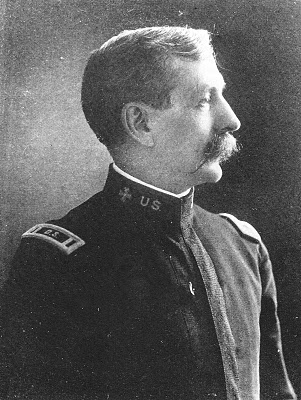Originally from England, Marshall immigrated at the age of 12 with his parents to the U.S. in 1858 and settled in Upstate New York. At 18, he volunteered and served as an enlisted man during the American Civil War, in which he participated in a number of the culminating combat engagements, including Appomattox, where his unit witnessed General Robert E. Lee's surrender to General Ulysses S. Grant.
After the war, he returned to New York, where he completed his schooling at the Fayettesville Academy, graduating in 1868. That same year, he apprenticed himself to two local dentists and was certified to practice dentistry a year later. Four years later, according to Lt. Col. Vail, "realizing the importance of a thorough education," Dr. Marshall matriculated at the medical school of the University of Syracuse, where he graduated with a Doctor of Medicine in 1876. Upon graduation, he joined the medical school faculty as a professor of oral and dental surgery -- a position he vacated in 1883 when he moved to Chicago.
Dr. Marshall had just recently been appointed the nation's first dental surgeon under a law enacted by Congress that authorized the hiring of 30 dentists by the U.S. Army. According to a 1940 paper on the founding of the Dental Corps authored by Lt. Col. W.D. Vail, DDS, Dr. Marshall's job as president of the examining board "was to [oversee the] selection of qualified dentists, provide them with suitable
January 28, 2014 -- In 1901, Chicago dentist Dr. John Sayre Marshall, MD, told a St. Paul Globe newspaper reporter that during the U.S. Civil War he witnessed a "soldier sit in a dentist's chair and undergo the tortures of Hades [hell]." The soldier was having a tooth pulled. According to Dr. Marshall, "the alleged dentist who treated him -- a hospital steward [i.e., a medic] -- inserted a turnkey into his face and attempted to pull the tooth. He twisted, yanked, drew, and jerked, until the tooth finally came out. Incidental to the extraction of the tooth, he broke the patient's jaw," adding "he almost killed the poor fellow."
Dr. Marshall explained that a turnkey was an "instrument that somewhat resembled the cant hook of the lumberman." Another common instrument he had witnessed stewards using were "tack hammers." Other accounts reveal hospital stewards used anything handy from "a brass tack to a sledgehammer." One era newspaper article noted "soldiers of the nation have suffered the tortures of the unmentionable in this respect ... [resulting] in broken jawbones ... [and lifelong] ... disfigurement."
Page 1
By Daniel Demers, DrBicuspid.com contributing writer
Continued Page 2
Courtesy of:


'You're in the army now':
2 mules and a folding chair
A peavey is a cant hook with a point.
equipment, [see to] their distribution throughout the service, and to prescribe methods of procedure that would insure the greatest efficiency for the number of dentists employed."

Dr. John Sayre Marshall, MD (1846-1922)
In Chicago, he opened a private dental practice and was also appointed as an instructor in dental and oral surgery in the faculty at Northwestern University School of Medicine. He was asked to organize the university's dental school and was appointed its first dean and professor of dental pathology. Historical records indicate his greatest pleasure was harelip and cleft palate reconstructive surgery, in which he specialized. While at Northwestern, he authored two scholarly texts: one on injuries and diseases associated with the face and mouth and one on dentistry. He resigned this position in 1896 and continued his private practice in Chicago. He also reorganized the American Dental College, which was merged into Northwestern's.
According to a 2009 study by Maj. Gen. Patrick Sculley, "the National Dental Association [now American Dental Association] had been pressing Congress to create a cadre of dental surgeons for the Army and Navy. In fact, its efforts extend back to its first convention in Washington, DC, in 1860 when it petitioned Congress to create a
E-MAIL ME ddemers901@sonic.net


